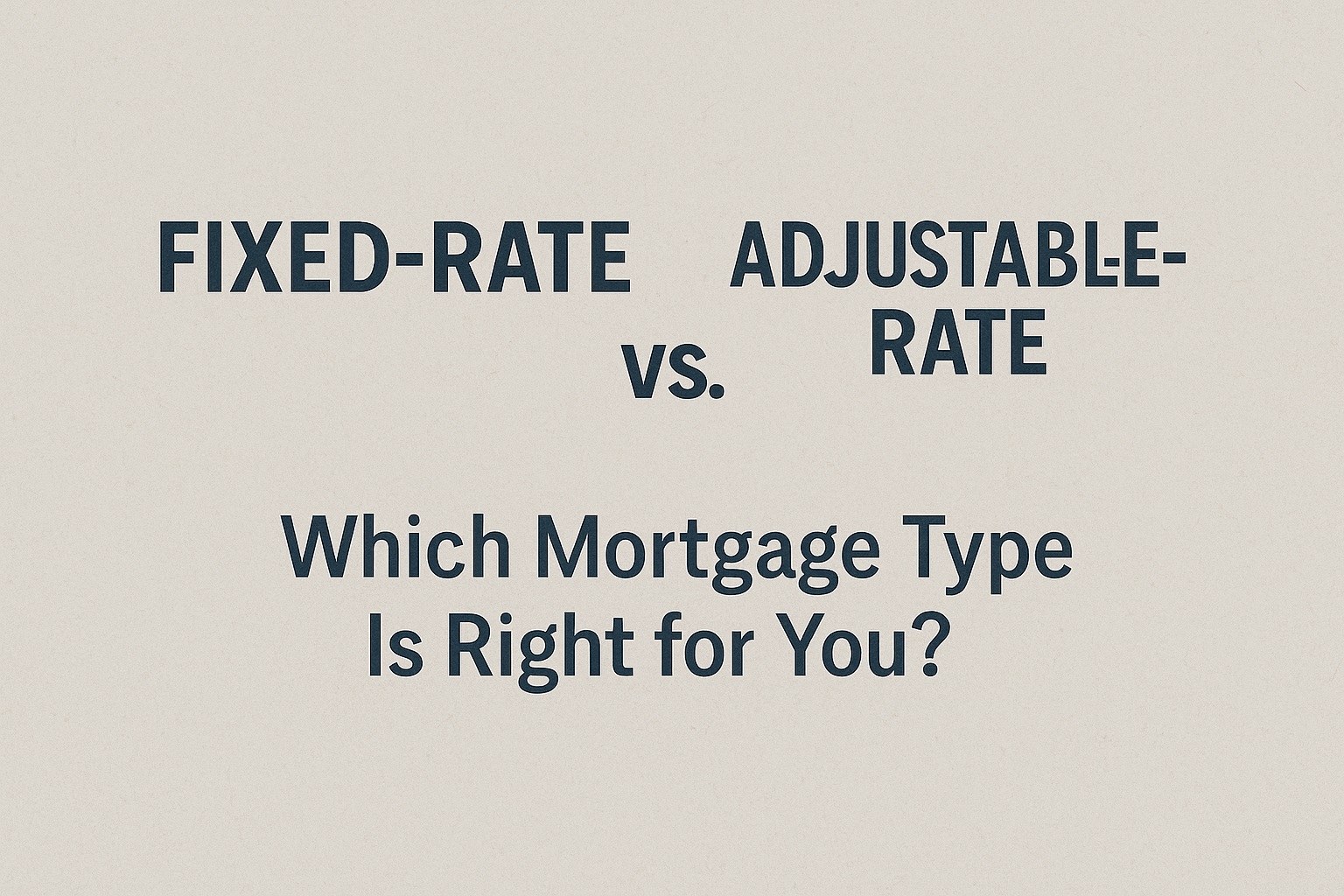In the world of home financing, one of the most critical decisions you’ll face as a borrower is choosing between a fixed-rate mortgage and an adjustable-rate mortgage (ARM). While both options allow you to purchase a home or refinance an existing mortgage, they differ significantly in how interest rates are structured, payment predictability, risk profile, and overall cost over the life of the loan. Making an informed choice can save you tens of thousands of euros—or cost you in unexpected rate hikes down the road.
This extensive guide will dive into every aspect of fixed-rate and adjustable-rate mortgages, including:
Understanding Mortgage Fundamentals
Before exploring specific mortgage types, it’s essential to grasp core mortgage concepts:
Principal vs. Interest
The principal is the amount you borrow. Interest is the lender’s fee, expressed as an annual percentage rate (APR), for lending you that money.
Amortization
Amortization refers to how loan payments are applied over time to principal and interest. Early payments comprise mostly interest; later payments pay down principal faster.
Term Length
Common mortgage terms include 10, 15, 20, and 30 years. Shorter terms typically have lower rates but higher monthly payments, while longer terms spread payments over more months.
Rate Quotation
Lenders quote mortgage rates as either fixed (unchanging) or adjustable (changing after an initial period based on an index plus a margin).
Understanding these fundamentals sets the stage for comparing fixed-rate and adjustable-rate mortgages.
What Is a Fixed-Rate Mortgage?
A fixed-rate mortgage locks in a single interest rate for the entire life of the loan. Whether you choose a 15-year or a 30-year term, your APR remains unchanged, ensuring payment stability.
How It Works
- You agree to an interest rate at closing.
- Monthly principal and interest payments remain constant for the loan’s duration.
- Every payment reduces your outstanding principal and covers interest accrued that month.
Advantages of Fixed Rates
- Predictable Budgeting: With a constant monthly payment, you can plan long-term without worrying about rate fluctuations.
- Protection Against Rising Rates: If market rates climb, your rate remains locked, shielding you from higher borrowing costs.
- Simplicity: Easier to understand and qualify borrowers often prefer the certainty.
Drawbacks of Fixed Rates
- Higher Initial Rates: Fixed rates typically start slightly above initial ARM rates to account for future rate risk.
- Limited Flexibility: If market rates drop significantly, you must refinance—and pay closing costs—to obtain a lower rate.
Use our Mortgage Basics resource for an in-depth primer on fixed loans.
What Is an Adjustable-Rate Mortgage (ARM)?
An ARM offers an introductory fixed-rate period—commonly 3, 5, 7, or 10 years—after which the rate adjusts periodically according to a specified index plus a lender margin.
ARM Components
- Initial Rate: Locked for the fixed period (e.g., 5 years for a 5/1 ARM).
- Index: A benchmark rate, such as the London Interbank Offered Rate (LIBOR) or Treasury yield.
- Margin: A percentage points add-on the lender charges above the index.
- Adjustment Frequency: How often the rate changes after the initial period, typically annually (e.g., 5/1 ARM adjusts once per year).
Rate Caps
- Initial Adjustment Cap: Limits increase at the first adjustment (e.g., 2%).
- Periodic Cap: Limits change at each subsequent adjustment (e.g., 2% per year).
- Lifetime Cap: The total maximum rate increase over the loan’s life (e.g., 5% above initial rate).
Advantages of ARMs
- Lower Introductory Rate: Initial rate often 0.5–1.0% below comparable fixed-rate mortgages.
- Potential Savings: If rates stay level or drop, you could pay less interest over the fixed period.
- Short-Term Ownership: Ideal for borrowers planning to sell or refinance before the first adjustment.
Drawbacks of ARMs
- Uncertain Future Payments: After the fixed period, payments can rise unexpectedly.
- Complexity: Index-plus-margin formulas, caps, and adjustment schedules can be confusing.
- Market Risk: Tied to economic factors outside the borrower’s control.
For a deeper dive into ARMs, explore our ARM Glossary page.
Interest Rate Comparison: Initial vs. Long-Term
When evaluating fixed-rate versus ARM, consider both the introductory period and potential long-term trajectory.
Scenario Analysis
Lenders quote a 30-year fixed rate at 4.50% and a 5/1 ARM at 3.75% with a 2/2/5 cap structure and a margin of 2.25% over the 1-year LIBOR index. If LIBOR is 1.50% at adjustment:
- Initial ARM rate: 1.50% + 2.25% = 3.75%.
- Maximum first adjustment: 3.75% + 2% = 5.75%.
- Lifetime cap: 3.75% + 5% = 8.75%.
Payment Comparison Example
Assume a €300,000 loan amount:
| Loan Type | Initial Rate | Initial PI Payment | Payment at Max Lifetime Rate |
|---|---|---|---|
| 30‑year fixed | 4.50% | €1,520 | €1,520 |
| 5/1 ARM | 3.75% | €1,389 | €2,363 |
After five years, if rates rise to the lifetime cap of 8.75%, your payment could nearly double compared to the fixed mortgage. However, if rates remain near 3.75%, you benefit from lower costs.
Payment Stability and Budgeting Implications
Fixed-Rate
- Real estate investors and risk-averse borrowers value predictable cash flows.
- Ideal for tight monthly budgets or locked retirement income.
ARM
- Younger buyers anticipating higher income or career mobility might accept payment variability.
- Requires buffer savings to absorb potential payment shocks.
Stress Testing Your Budget
Calculate your monthly payment if the ARM hits its periodic and lifetime caps. Confirm you can afford that worst-case scenario without dipping into critical savings.
Adjustment Periods, Indexes, and Caps Explained
To fully understand an ARM’s risk, analyze each component:
Index Volatility
- LIBOR is being phased out; today’s ARMs often tie to the Secured Overnight Financing Rate (SOFR).
- Historical volatility: SOFR averaged 0.10%–0.50% pre-2022 but spiked above 5% in 2024.
Margin Negotiability
- Borrowers with strong credit profiles may negotiate a margin as low as 2.00%.
- Credit unions and community banks often offer competitive margins.
Cap Structures
- 5/1 ARMs: 5-year fixed period; annual adjustments thereafter.
- 7/1 ARMs: 7-year fixed; can hedge longer fixed rates with still lower initial APRs.
Hybrid ARM Variations
Some lenders offer 3/1/5 caps (e.g., initial 3% max first adjustment, 1% periodic, 5% lifetime) to balance risk and reward.
Pros and Cons of Fixed-Rate Mortgages
Pros:
- Lifetime payment certainty
- No rate-adjustment complexity
- Easier to qualify for budgeting
Cons:
- Higher initial payment versus ARM
- Refinancing to lower rate incurs fees
- Limited benefit if rates drop marginally
Pros and Cons of Adjustable-Rate Mortgages
Pros:
- Lower initial rate saves thousands in early years
- Attractive for short-term homeowners
- Potentially lower lifetime interest if rates fall
Cons:
- Payment volatility can strain finances
- Harder to project long-term interest costs
- Complex caps and index tracking
Ideal Scenarios for Choosing Fixed-Rate Loans
- Long-Term Ownership: Planning to stay 10+ years.
- Stable Income Needs: Retirees or households on fixed budgets.
- Low Risk Tolerance: Prefer certainties over market bets.
Ideal Scenarios for Choosing ARMs
- Short Ownership Horizon: Expect to sell/refinance before adjustment.
- Significant Income Growth: Young professionals confident of future earnings.
- Falling Rate Environment: Expect central bank rate cuts within the fixed period.
How to Shop and Compare Mortgage Offers
- Gather Personalized Rate Quotes: Use the Loan Estimate form from at least three lenders: banks, credit unions, and online mortgage providers.
- Compare APR, Not Just Rate: APR includes fees—provides apples-to-apples comparison.
- Review Cap Structures and Indexes: For ARMs, ask lenders for historical index values and sample adjustment schedules.
- Estimate Total Cost Over Ownership Period: Run scenarios at various rate trajectories.
- Check Lender Reputation: Research customer reviews and complaint databases.
Step-by-Step Decision Framework
- Define Goals: Lower payments now vs. long-term stability.
- Assess Timeline: How long until you sell or refinance?
- Evaluate Risk Profile: Are you comfortable with rate swings?
- Conduct Break-Even Analysis: Determine how long advantage persists.
- Factor in Fees: Origination, appraisal, title, discount points.
- Consult Advisors: Tax implications and market forecasts.
Frequently Asked Questions (FAQs)
Q1: What happens if interest rates fall during my fixed term?
You’ll need to refinance to capture lower rates, bearing closing costs.
Q2: Can I convert my ARM to a fixed mortgage mid-term?
Many lenders offer conversion options—often with a fee and based on current market rates.
Q3: What credit score do I need for the best ARM rates?
Typically 740+ for top-tier pricing; 620–740 yields higher margins.
Q4: Is there a prepayment penalty for ARMs?
Some ARMs include penalties for paying off the loan early—review your loan agreement.
Q5: Are ARMs riskier in a high-inflation environment?
Yes. Inflation often leads central banks to raise benchmark rates, pushing ARM payments higher.
Choosing between a fixed-rate mortgage and an adjustable-rate mortgage requires balancing immediate savings against long-term predictability. By understanding rate structures, cap mechanics, and aligning with your ownership timeline, you can select the mortgage type that best fits your financial goals. Always run scenarios for multiple rate pathways, compare true costs via APR, and plan for worst-case adjustments.








